Abstract
Climatic factors have a strong influence on the occurrence of forest diseases and pests, but few studies have systematically analyzed the influence of spring climatic factors on the occurrence of forest diseases and pests in China. We collected inventory data of forest resources, forest diseases, and pest occurrences and then analyzed the spatial and temporal characteristics of China’s forest diseases and pests from 1992–2019. Next, we took spring temperature accumulations ≥ 10 °C, spring average precipitation, and spring average radiation as the spring climatic factors and analyzed their influence on China’s forest diseases and pests with partial correlation and piecewise trend methods. The results showed that the incidence rate of forest diseases and pests in China had a nonlinear decreasing trend that occurred simultaneously with the growth of forested areas and the increase in forest pest and disease areas. Ultimately, the increase in forest pest and disease areas stabilized at low levels of 1% and 4%, respectively. This change generated a spatial shift from an east–west to a north–south pattern in China. Additionally, the average turning points of forest disease and pest incidence trends in China occurred in 2000 and 2005, where 56.7% and 63.3% of provinces, respectively, experienced significant shifts in forest disease and pest incidence. Finally, spring meteorological elements had a significant role in driving the mechanisms of forest disease and pest incidence in China. Among these, spring temperature accumulation was a major contributor in disease and pest variability in China. However, spring radiation and spring precipitation were important local drivers in Southwest China, though these two factors had two opposing shifts in forest diseases and pests reflected over time. This study systematically analyzed the impact of climate change on the development of forest diseases and pests in China, helping clarify the future control of forest diseases and pests in China.
1. Introduction
Forests are vulnerable to various natural disasters and human-induced damages [1]. Harmful forest organisms, a major contributor to forestry disasters, pose a serious threat to forest resources and cause significant losses to forestry production [2,3]. Forest ecosystems are the first to respond to the effects of global climate change [4]. As the growing season, spring has a strong influence on forest vegetation and the development of forest pathogens and insect eggs [5]. Certain spring climatic factors may lead to high tree mortality or outbreaks of forest diseases and pests. These conditions can also lead to changes in the range of forest pathogens and pests [6].
Since the 1950s, the range of harmful forest organisms in China has increased each year [7]. China’s forested areas had reached 220.4462 million hectares by 2019, and 5.7% of the area was occupied by major forest pests. In the 1980s, two invasive alien species, namely, Bursaphelenchus xylophilus and Hyphantria cunea, spread from Nanjing and Liaoning to the North China Plain and eventually reached most provinces in China [8]. These species caused great damage to China’s economy and ecological environment, while the native horsetail pine caterpillar gradually became the most destructive pest in southern China [9].
Climate change can expand the distribution of native and exotic forest pests (insects and pathogens) and affect the resistance of trees to pests [10]. Many papers have shown that the duration, severity, and spatial variability of forest disease and pest outbreaks over the past 20 years have been profoundly influenced by spring climatic elements [11,12]. The spring temperature rise shortens the developmental time of pathogens and eggs, thus strengthening their ability to spread and infect [13,14,15]. A spring temperature accumulation ≥ 10 °C is an important indicator of the ecological thermal conditions of vegetation and crops [12]. Both pathogenic bacteria and insect eggs incidental to the forest itself need suitable temperatures to enter the developmental period and thus start a new generation of reproduction [16].
Heat availability is an abiotic condition necessary for the development of vegetation and microorganisms. Spring radiation affects the development of larvae by increasing their body temperature, and its amount is positively correlated with larval development [17]. An appropriate amount of radiation directly encourages the biological cycle of the new generation and promotes plant photosynthesis [18]. Forest areas with higher terrain receive more solar radiation, and these areas are highly susceptible to pest outbreaks because this is where larvae are more likely to aggregate [19]. Additionally, the heat input from solar radiation in higher places offsets the decrease in temperature [20], which is crucial for larval and microbial development.
Climate plays a significant role in determining the growth and dispersion of forest vegetation [16,21,22]. The hydrologic and thermal conditions required by plants and microorganisms are largely controlled by regional temperature and precipitation [23]. Adequate precipitation is fundamental to the growth of forest vegetation, and the potential mechanisms influencing the relationships between precipitation, forest diseases, and pests often involve changes in host plants [10,24]. In particular, water deficits, such as drought, may lead to tree mortality and indirectly cause the death of pathogens and insects [25,26]. Similarly, drought enhances insect outbreaks and pathogen epidemics [26,27]. Increased precipitation in spring creates the optimal wet and hot developmental conditions for pathogens [28] and promotes the development of incidental pathogens and insect breeding (and thus egg laying) in forests. Climatic factors such as temperature, radiation, and precipitation are important drivers of forest disease and pest disturbance mechanisms and can have serious consequences for biodiversity and ecosystem function [29,30].
Numerous contemporary studies have focused on annual climatic changes, but these macroscale analyses have not focused on the mechanisms influencing the spring climatic factors that drive forest diseases and pests in China’s provinces [29,31,32,33]. During the last 20 years of sustained warming, it has been shown that temperature directly affects the growth of hosts and pathogens by changing their life cycle, thus promoting the growth of forest diseases and pests [34] while also leading to anomalous local forest diseases and pests. Several studies have suggested that the occurrence and severity of forest diseases and pests are positively correlated with spring temperatures and spring precipitation [35,36], that higher temperatures in spring tend to reduce pest mortality [33], and that spring precipitation promotes pathogen development. There is evidence that spring moisture is critical for forest pest development due to geographic variations in cold and dry winter conditions [37]. Spring radiation directly affects larval performance [17] and, at the same time, promotes the growth and development of forest plants, which in turn affects forest pest development. In addition, the vast geographical area of China and the large latitudinal distances between the north and the south lead to large differences in climatic environments. Therefore, it is necessary to conduct research on the mechanisms that drive the spring climatic factors, which in turn influence forest diseases and pests in China.
In this study, we analyzed regional trends and incidences of forest diseases and pests in China from 1992 to 2019 to understand how forest diseases and pests have changed over a climatic cycle of about 30 years. Using partial correlation analysis, we comprehensively explored the changing characteristics of forest diseases and pests in China as a whole and in each province and the mechanisms influencing the spring climatic factors. This study addresses the following scientific objectives: (1) to investigate how the spatial and temporal characteristics and trends of forest diseases and pests in China vary over an approximately 30-year climate cycle and to note whether there are significant transitional features; (2) to investigate how spring climatic factors drive changes in forest diseases and insect-related pests in China.
2. Materials and Methods
2.1. Forest Diseases and Pests and Forest Area Data
The forest areas of pest and disease incidence were derived from a total of 28 issues of the Chinese Forestry Statistical Yearbook (1992–2019). These issues are based on the annual statistical reports and other relevant information reported by provincial forestry management departments, autonomous regions and municipalities directly under the State Forestry Administration, and units directly under the State Forestry Administration.
The forest area was derived from the National Forest Resources Survey Report from the State Forestry Administration of China, which was published every five years from 1989 to 2020. The Forest Resource Survey was conducted by provinces (including districts and municipalities) with fixed sample sites as the main unit and employed regular reviews to investigate and verify the distribution and quality of various types of forest resources within a certain area. The forest areas discussed in this paper are all based on the areas assessed during the years of the forest resource inventory. Each year assigned to a forest area represents the following five years as well, which is consistent with the forest area methodologies recorded in the Chinese Forestry Statistical Yearbook.
In this work, forest pest and disease data from 30 provinces in China, excluding Tibet, Taiwan, Hong Kong, and Macao, were selected for analysis.
2.2. Climate Data
2.2.1. Temperature and Precipitation Data
Temperature and precipitation gridded data were obtained from the NCAS UK National Centre for Atmospheric Sciences CRU TS v. 4.05 monthly dataset and the NOAA Climate Prediction Center (CPC) daily dataset, both at 0.5° × 0.5° resolution. In this study, spring (defined as March, April, and May) temperature accumulation with daily values ≥ 10 °C and the average spring precipitation data from 1992 to 2019 were calculated. These values are uniformly referred to as spring temperature and spring precipitation throughout this paper. Temperature and precipitation data were obtained for each province of China using the zonal statistics tool in ArcGIS 10.2.
2.2.2. Solar Radiation Data
The solar radiation data are from the CRU-NCEP V5.2 dataset, which has the same spatial resolution as the CRU climate data. This dataset was obtained by combining the 0.5° × 0.5° climate dataset (1901–2012) of CRU TS3.21 and the NCEP reanalysis 2.5° × 2.5° dataset (1948–2016) [38]. The average spring radiation data from 1992 to 2019 were used in this study and are uniformly referred to as spring radiation throughout this paper. Spring radiation data for each province in China were obtained using the zonal statistics tool in ArcGIS 10.2.
2.3. Incidence of Forest Diseases and Pests
The formula for calculating the incidence of forest diseases and pests in China in this study is shown in (1):
where is the forest disease incidence rate of each province in China, is the forest disease incidence area of each province in China, and is the forest area of each province in China. The forest pest incidence rate and disease incidence rate of each province in China were calculated using the same methodologies.
2.4. Determination of Primary Forest Disease and Pest Factors
Biased correlation analysis is the analysis of the degree of correlation between two variables under the condition that the interference of other factors is eliminated. Spring precipitation and spring radiation were not considered when calculating the correlation between the incidence of diseases and pests and spring temperature accumulation in this study, though the correlations were calculated in the same way as when spring precipitation and spring radiation are considered [14]. The equation is shown in (2):
In this study, spring temperature accumulation, spring precipitation, and spring radiation are -factors, and is the forest disease incidence. In Equation (2), is the correlation coefficient between and forest disease incidence when is fixed. The partial correlation analysis of forest pests and spring climatic factors in each province of China was calculated similarly to that of forest diseases.
In this study, the primary factors of forest disease and pest incidence were identified as the factors with the highest absolute values of the coefficient from the partial correlation analysis.
2.5. Univariate Linear and Piecewise Trend Regression
Univariate linear regression is a widely used fitting method for analyzing time series change trend data. In this study, we analyzed the overall trend of forest diseases and pests in China based on 28 years of forest disease and pest incidence areas and incidence rates. The equation is shown in (3):
In the calculation of the forest disease incidence area trend, is the forest disease incidence area, is the time range (1992–2019) in years, is the slope of the trend, is the intercept, and is the residual of the fit. The trends of forest disease incidence rates and forest pest incidence areas and incidence rates were calculated in the same way as the forest disease incidence area trends.
To analyze the stages of forest diseases and pests in China, a turning point (TP) was set by the piecewise trend regression method to further analyze the changing trends and correlations between forest diseases and pests and spring climatic factors [39], and the equation is shown in (4):
where is the forest disease incidence rate; is the year; is the turning point (TP) of the forest disease incidence trend; , , and are regression coefficients; and ε is the residual of the fit. The forest disease incidence trend is before the turning point and after it. The piecewise trend analysis of forest pest is consistent with the forest disease calculation.
Different time lengths lead to insufficient sample sizes that are prone to edge effects. Therefore, the first and last 6 years between 1992–1994 and 2016–2019 were not identified as significant turning points in this study, and only the turning points between 1996–2015 were analyzed.
3. Results
3.1. Interannual Spatial and Temporal Patterns of Forest Area and Pests in China
3.1.1. Spatial and Temporal Patterns of Forest Area in China
China’s forested area had reached 220.4462 million hectares in 2019, accounting for 5.51% of the world’s forested area, and its forest coverage rate was 22.96%. China’s forests increased by 95.7934 million hectares during 1984–2018, of which 86.7427 million hectares were added between 1993 and 2018, with an average annual increase of 2.8175 million hectares. Six provinces—Inner Mongolia, Yunnan, Heilongjiang, Sichuan, Xizang, and Guangxi—together account for 52.57% of the total forest area in China.
From 1992 to 2019, China’s forest area increased substantially and showed a “+” distribution (Figure 1). Among them, Northeast and Southwest China are the two largest areas of primary natural forests in China, with Inner Mongolia and Heilongjiang provinces alone accounting for 27% (37.62 million hectares) of the country’s natural forests. The coastal areas of South and East China are the largest economic forest bases in China due to their hot and humid locality, with Yunnan and Guangxi provinces alone containing 20% (4.14 million hectares) of the country’s economic forests. The North China Plain area is mainly agricultural, and the Northwest region has a harsh environment with severe soil erosion and is mostly shrubbery. Due to the implementation of various policies related to the protection of forests, such as the return of farmland to forests, the forested areas in other regions of China, except for the agricultural area of the North China Plain and the grassland area of Qinghai, have increased significantly.
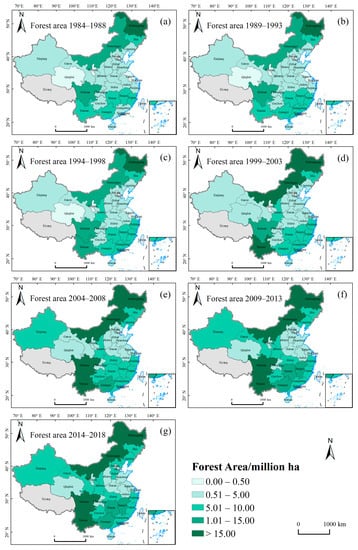
Figure 1.
Area of forest resources in China, 1984–2018 (a) Area of forest resources in China, 1984–1988; (b) Area of forest resources in China, 1989–1993; (c) Area of forest resources in China, 1994–1998; (d) Area of forest resources in China, 1999–2003; (e) Area of forest resources in China, 2004–2008; (f) Area of forest resources in China, 2009–2013; (g) Area of forest resources in China, 2014–2018.
3.1.2. Analysis of the Overall Spatial and Temporal Patterns and Trends of Forest Pests and Diseases in China
During 1992–2019, the area of forest disease and insect pest incidence in China increased by 708,400 and 1,542,800 hectares, respectively, with an average annual increase of 25,300 and 55,100 hectares, respectively. However, the incidence rate decreased by 0.30% and 1.93%, respectively, with an average annual trend of −0.011% and −0.069% over the 28 years, respectively (Figure 2). By 2019, the area of forest diseases and pests in China occupied 18.56% and 65.61% of the forest harmful creatures area, respectively.

Figure 2.
Trends in the area and incidence of forest diseases and pests in China, 1992–2019.
The area and incidence of forest pests had a substantial reduction trend during 1992–1998, and the incidence area increased substantially after 1998, from a minimum of 5,398,600 hectares in 1998 to a peak of 8,783,200 hectares in 2007; the incidence rate had a modest increase with the increase in the forest area after 1998, reaching 5.006% in 2007 and then gradually decreasing. Both forest disease area and incidence rate had a relatively substantial reduction trend during 1992–2004, but then the disease area began to increase, reaching a maximum of 2,211,500 ha in 2019; however, the incidence rate tended to stabilize during 2004–2017 and increased significantly to reach 0.98% after 2017. During 1992–2019, with the simultaneous expansion of forest disease and pest incidence areas and forest areas, China’s forest disease and pest incidence trends gradually slowed down and stabilized below the 1% and 4% levels, respectively.
Forest diseases and pests in China showed a substantial spatial pattern of “high in the north and low in the south”, with the incidence area and incidence rate of forest diseases and pests generally higher in the north than in the south. At the same time, the incidence area and incidence rate of forest pests were approximately 2–4 times more intense than those of forest diseases (Figure 3).
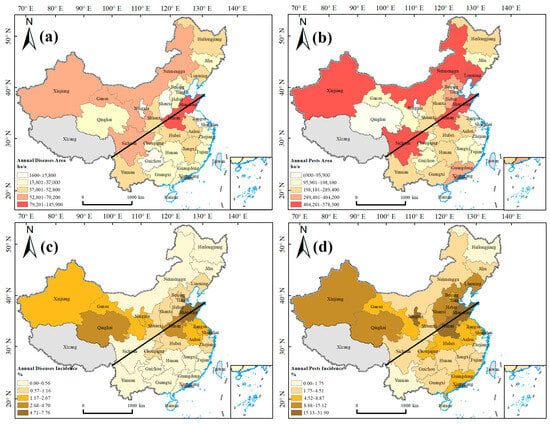
Figure 3.
Average annual area and incidence rate of forest diseases and pests in China, 1992–2019. (a) Average annual disease area; (b) average annual pest area; (c) average annual disease incidence; (d) average annual pest incidence. The black line in the figure indicates the intensity “boundary” for forest diseases and pests.
The spatial pattern of the average annual incidence area and incidence rate of forest diseases and pests was highly consistent, with both the Northwest and North China provinces being the most affected areas. Among them, Henan and Shandong were the two regions with the highest disease and pest incidence area and incidence rates in China. Specifically, Xinjiang and the North China Plain maintained a high incidence area and incidence rate; Inner Mongolia and Sichuan provinces had a high incidence area but a low incidence rate, indicating their overall disaster level was lower. Qinghai, in contrast, was more seriously affected. The dominant tree species in regions with high incidence areas and incidence rates included Populus, Cupressus, Pinus, and Picea. The invasive species of Bursaphelenchus xylophilus and Hyphantria cunea, which are Class I and Class II forest pests in China, respectively, posed significant threats to the forest health of these regions. Both share the common characteristics of low forest area and predominantly plantation forests in the double highlands region. In Inner Mongolia and Sichuan provinces, both have high forest area, which resulted in a higher area but lower incidence rate in the region.
The incidence of forest diseases and pests in China showed an overall reduction trend during 1992–2019, with only some provinces showing an increasing trend (Figure 4). During 1992–2019, western China and the North China Plain were the areas most affected by forest diseases and pests (Figure 3). Regarding provincial trends of incidence changes, the trend was an increase in Inner Mongolia, Liaoning, Tianjin provinces in northern China and the southern coastal provinces, while the trend was substantial reduction in the formerly most affected areas in the east and west. This pattern gradually developed the characteristics of transferring forest diseases and pests from east-west to north-south in China.
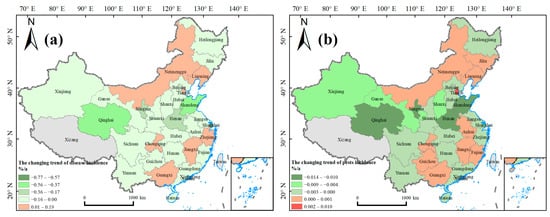
Figure 4.
Trends in the incidence of forest diseases and pests in China by province, 1992–2019. (a) Diseases; (b) pests. “%/a” indicates the annual incidence rate of pests and diseases in forests.
The incidence of forest diseases and pests showed a reduction trend in approximately 70% of the provinces in China. Among them, forest diseases showed the highest degree of reduction in Shanghai, where the incidence rate decreased by approximately 0.77% per year, while Tianjin showed the highest increase of 0.19% per year; the forest pest incidence rate weakened by approximately 0.014% each year in Qinghai province and increased by an annual rate of 0.01% in Tianjin. Additionally, the trend of increasing forest disease and pest incidence rates was much lower than the reduction trend, with the highest being only 0.19% per year. This also indicates that the overall expansion of forest diseases and pests is benign in China.
3.2. Climatic Drivers of Forest Diseases and Pests in China
3.2.1. Spatial and Temporal Patterns of Spring Climatic Factors in China
Spring climatic factors have a large spatial and temporal variability across China’s provinces over a climate cycle of approximately 30 years (Figure 5). Spring temperature accumulation and spring radiation are generally high nationwide, and spring precipitation is only generally greater than 400 mm/a (“mm/a” indicates rainfall per year) in the coastal areas of eastern and southern China. The spring temperature accumulation increases from high latitudes to low latitudes, and the national universal spring temperature accumulation exceeds 1000 °C, which is a widespread high temperature. Spring radiation is higher in high latitudes and higher in Shandong and Henan.
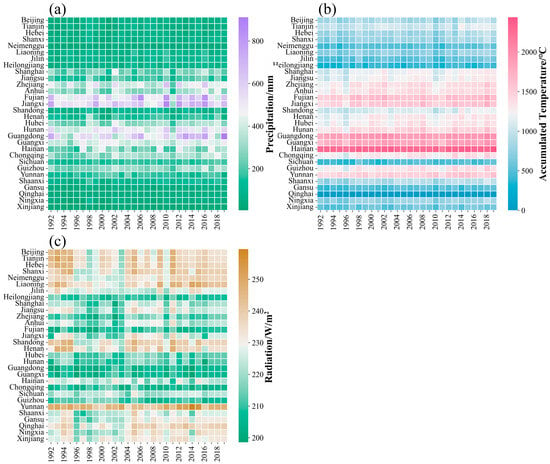
Figure 5.
Time series of spring climatic factors in China by province, 1992–2019. (a) Spring precipitation; (b) spring temperature accumulation; (c) spring radiation.
3.2.2. Primary Factors of Forest Diseases and Pests in China
The incidence of both forest diseases and pests in China was dominated by spring temperature accumulation and spring radiation, with the ratios of provinces in which spring temperature accumulation, spring precipitation, and spring radiation were dominant being 15:5:10 and 12:8:10, respectively (Figure 6), which showed consistency with the generally high values of spring temperature accumulation and spring radiation nationwide. Furthermore, among forest diseases, both spring temperature accumulation and spring radiation were dominant on a large scale, and spring precipitation was dominant only locally in southern China. However, in forest pests, all three spring climatic factors showed a large range of dominant surface spatial characteristics.
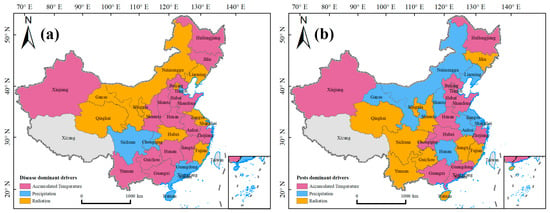
Figure 6.
Primary factors of forest pest incidence, 1992–2019. (a) Diseases; (b) pests.
Regarding forest diseases, the primary factor in Inner Mongolia, Qinghai, and Gansu in northern China was spring radiation, while the primary factor in most of southern China as well as Xinjiang and the Northeast China was spring temperature accumulation; spring precipitation was the primary factor only in local provinces in Southwest and South China (Figure 6a). In contrast, the primary characteristics of forest pests differed from those of forest diseases. With spring radiation being the primary factor in most of Southwest China, spring precipitation was the primary factor in most of North China, and spring temperature accumulation was more dominant primarily in Central and South China (Figure 6b).
3.3. Analysis of Forest Disease and Pest Turning Point and Driving Mechanisms in China
3.3.1. Analysis of the Turning Point of Forest Diseases and Pests in China
The peak incidence of forest diseases and pests in China was in the 10-year periods of 1996–2005 and 2001–2010, respectively, and the average turning points were in 2000 and 2005, respectively. Meanwhile, forest disease and pest turnaround periods varied widely (Figure 7). In the border provinces of China, forest diseases had already turned at the end of the 20th century, followed by most of North and Central China during the first five years of the early 21st century, while forest pests started to turn only at the beginning of the 21st century.
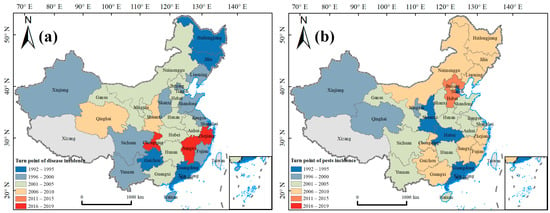
Figure 7.
Turning point of national forest disease and pest incidence 1992–2019. (a) Diseases; (b) pests.
3.3.2. Transition Characteristics of the Incidence of Forest Diseases and Insect Pests in China
The characteristics of changes in the incidence of forest diseases and pests in China could be categorized into three types: stable, decreasing followed by increasing, and increasing followed by decreasing. Forest diseases and pests have significant change characteristics in 56.7% and 63.3% of the provinces, respectively. The changing characteristics of forest diseases and pests had a large difference, with diseases mainly decreasing and then increasing, while pests showed the opposite pattern (Figure 8).
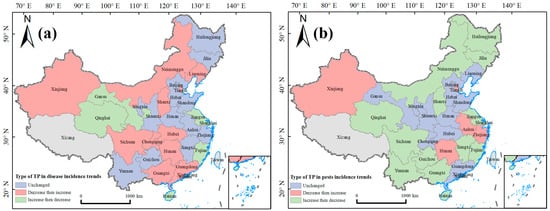
Figure 8.
Characteristics of transitional changes in the incidence of forest diseases and pests in the country by province, 1992–2019. (a) Diseases; (b) pests.
Forest diseases showed a decreasing trend before increasing in North, Central, and South China, while only Qinghai and Gansu in Northwest China and Jiangsu and Fujian in East China showed increasing trends before decreasing (Figure 8a). While forest pests in Northeast, North, and Southwest China increased before decreasing, Xinjiang in Northwest China, Anhui and Zhejiang in East China, and Hubei in Center China decreased before increasing (Figure 8b). There was a certain overlap of stable forest pest incidence areas, mainly in the North China Plain and Central China. Forest diseases showed stability in the two provinces of Northeast, North, South, and Southwest China; only Jiangxi and Zhejiang provinces showed a consistently increasing trend, while all other regions showed a consistently decreasing trend. The incidence rate of forest insect pests showed stability in North China, Central China, and Guangdong province; only Chongqing and Liaoning province showed a consistently increasing trend, while all other regions exhibited a consistently decreasing trend.
Additionally, although mostly decreasing and then increasing, the overall trend in forest diseases was still downward. The data also indicated that the trend of reduction in the early part of the turn was stronger than the trend of increase in the late part of the turn; among forest pests, most of the northeastern, southern, and eastern coastal areas increased first and then decreased after the turn, but the overall trend was up. The data also reflected that during the climatic cycle of approximately 30 years, the previous trend dominated the overall trend in areas where forest diseases and pests had changed; in areas where the trend was stable and unchanging, the overall trend was generally a reduction.
3.3.3. Turning Point Analysis of Spring Climatic Factors on Driving Mechanisms of Forest Diseases and Pests in China
The driving effect of spring climatic factors on forest diseases and pests in China was significant, with more than 50% of the provincial drivers of both forest diseases and pests in China shifting. Among them, forest diseases and pests were dominated by spring radiation and spring precipitation, respectively, in the period prior to the turn (Figure 9a,c). However, in the late turn period, spring temperature accumulation shifted from exerting sporadic dominance before the turn to exerting total dominance over forest diseases and insect pests in China afterwards. Here, spring temperature accumulation dominated forest diseases and pests in 43% and 36% of provinces in China, respectively (Figure 9b,d). In contrast, spring radiation and spring precipitation drivers decreased.
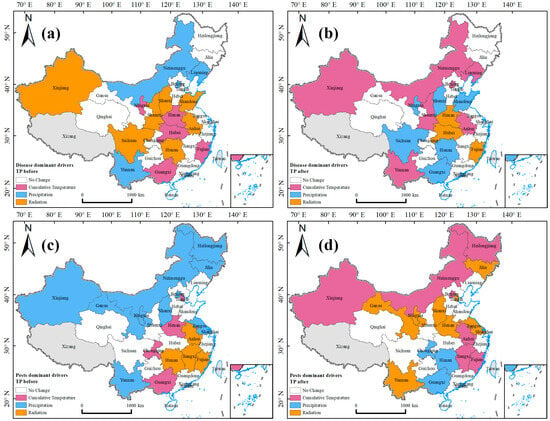
Figure 9.
Driving factors before and after the turning point of forest diseases and pests. (a,b) Before and after the turning point of diseases; (c,d) before and after the turning point of pests.
During the late transition period, the number of provinces with spring temperature accumulation as the primary factor for forest diseases and pests in China increased significantly and showed a continuous surface distribution, while spring radiation and spring precipitation were primary only in localized areas. At the same time, the driving factors of forest diseases showed a local shift from spring radiation to spring precipitation, while the opposite was true for pests.
Forest diseases and pests had consistent transition characteristics in the border provinces of North and South China, while they showed large differences in the North China Plain and East China localities (Figure 9). At the late turning point of forest diseases and pests, spring temperature accumulation dominated, while spring precipitation and spring radiation only exerted greater dominance in the rainy coastal provinces of Southwest and South China and the high-radiation local provinces of North and Central China, respectively.
Before the forest disease turning point, Inner Mongo, Tianjin, and Liaoning in North China and Yunnan province in Southwest China were dominated by spring precipitation, while in Xinjiang and Central China, they were dominated by spring radiation, and areas affected by spring temperature were scattered in Hubei, Hunan, Guangxi, and Fujian. After the turning point, the prevalence of provinces formerly dominated by spring radiation shifted to spring precipitation, and provinces formerly dominated by spring precipitation shifted to spring temperature accumulation.
Before the turning point of forest pest incidence, Anhui, Jiangxi, Fujian, and Hubei provinces in East China were dominated by spring radiation, while in Hubei, Chongqing, and Guangxi, spring temperature accumulation dominated. Areas dominated by spring precipitation were distributed in the border provinces of China. After the pest incidence turning point, the areas originally dominated by precipitation in the border provinces changed to being dominated by spring temperature, followed by spring radiation. In contrast, the original East China coastal region shifted from being dominated by radiation to spring temperature accumulation.
4. Discussion
We analyzed the spatial and temporal patterns of forest diseases and pests in China during 1992–2019 and combined them with spring climatic factors to identify and analyze the driving mechanisms of forest diseases and pests. The results of the study are as follows: (1) Over 28 years, the forested areas impacted by diseases and pests increased by 708,400 and 1,542,800 hectares, respectively, but the incidence rates decreased by 0.30% and 1.93%, respectively, and showed a significant spatial pattern of “high in the north and low in the south”. (2) For both forest diseases and pests in China, spring temperature accumulation and spring radiation were the primary factors, but there were geographical differences. For forest diseases, spring radiation was the primary factor in northern China, while spring temperature accumulation was the primary factor in South China. For forest pests, spring radiation was the primary factor in Southwest China, while spring precipitation was the primary factor in northern China. (3) The average turning points of forest disease and pest incidence in China were 2000 and 2005, respectively. The changes in forest disease and pest characteristics were significantly different, with forest disease mainly decreasing and then increasing, while forest pests mainly increased and then decreased. (4) The influence of spring temperature accumulation on forest diseases and pests has been increasing, and after the turning points, the primary factors in many regions changed from spring precipitation and spring radiation to spring temperature accumulation.
During 1992–2019, the growth rate of China’s forested areas was much greater than the areas of forest pest incidence; therefore, the incidence of both forest diseases and pests showed a linear decreasing trend. In recent decades, China has become the world’s largest afforestation country due to major forestry projects, such as the Three-North Shelterbelt Project and the Sloping Land Conversion Program [40]. Additionally, forest security risks have increased, and Chinese forests are subject to a combination of native and invasive alien species [41]. This has led to a substantial increase in the incidence of forest diseases and pests. This is also often caused by anthropogenic transmission [42]. Forest epidemic control in China tends to consist of post-disaster management and natural control, and no emphasis has been placed on disaster prevention and artificial control [43,44]. Hao and others reported that Bursaphelenchus xylophilus in China spreads from south to north., and our results also showed a spatial shift of forest diseases and pests from east–west to north–south in China [45].
The Chinese terrain is complex, and the southern and northern latitude spans are large, thus giving rise to the solar radiation distribution characteristics of being high in the west and low in the east, while temperatures are high in the south and lower in the north [46]. Both forest diseases and pests are driven by a wide range of spring temperature accumulation and spring radiation, and drought and high radiation often lead to forest disease and pest outbreaks [13,18,26]. The pathogenesis of forest diseases and pests is quite different, and thus, the driving mechanisms of spring climate elements are also variable. Goheen and Willhite and others reported that forest diseases tend to grow optimally with hot and humid conditions, which explains why forest diseases are dominated by spring radiation in the north and by spring temperature accumulation in the south [47]. Forest pests require flight and larval reproduction in order to spread; thus, suitable precipitation and heat sources for larval development are crucial [17,25].
The last two decades have been the warmest period since the 20th century [46]. The continued warming of the climate system in China has led to a shift in the trends of forest disease and insect/pest incidence, which was caused by a combination of invasive species and outbreaks of exotic species during 1980–2005 [48]. In the early period, invasive species, mainly pine nematodes and American white moths, were not effectively controlled due to the low prevention capacity of forestry technicians. From 2000 to 2005, the government implemented relevant policies and effective control methods to contain them [49], and the incidence of forest pests was significantly reduced. However, the lack of forest diversity in China and the short-term economic forestry trade have easily caused the devastation and destruction of forests to increase, which in turn has led to the increase in forest disease incidence in China [50].
Although the climatic environment in China is highly variable, spring temperature accumulation remains the primary driver and dominates over a large range. Simultaneously, due to the continuous warming of the climate system, the driving force of spring temperature accumulation is increasing, and the driving force of spring radiation and spring precipitation is decreasing [51,52]. The need for minimum temperatures for forest vegetation and microorganisms to develop in spring is the main reason for this phenomenon [21]. However, the influencing mechanisms are nonlinear [53]. For example, higher spring temperatures can accelerate growth for pathogens and insects and can also lengthen the developmental time. Radiation and precipitation have a lower impact than temperature on forest pests [21], and thus, spring temperature accumulation after the turning point is the most primary climatic factor of forest pests and diseases in China.
In this work, we analyzed the transformation mechanisms behind forest diseases and pests in each province of China, summarized the spring climate drivers of forest diseases and pests in each province, and finally explored the impact of spring climatic factors on forest diseases and pests. This work will enable us to take necessary measures to offset or mitigate negative impacts on forest ecosystems and provide a theoretical basis for the early prevention and control of epidemics in each province.
This work was not without certain shortcomings. The mechanisms behind the spring climatic factors that influence forest diseases and pests are comprehensive and interactive; thus, it is difficult to consider their effects on forest diseases and pests in China in an integrated manner. In this work, we developed a partial correlation analysis model for three spring climatic factors to analyze the mechanisms behind the spring climatic factors that influence forest diseases and pests in 30 provinces, except Xizang, Taiwan, Hong Kong, and Macao, and emphasized only the driving mechanisms of the three spring climate elements in the correlation. In the future, it will be necessary to further consider the internal fluctuations and cyclical effects of spring climatic factors. The work of the driving mechanisms of forest pests and diseases in China will be improved if the influence of anthropogenic transmission in each province is also considered.
5. Conclusions
In this study, we examined the spatial and temporal patterns of forest diseases and pests in China and analyzed the driving mechanisms of spring climatic factors and forest disease and pest incidence in terms of biased correlations and piecewise trend turning points. During 1992–2019, the intensity of forest pests in China was generally 2–4 times higher than that of forest diseases, and the incidence area of both remained high. Meanwhile, with the significant growth of forested areas, the incidence of both forest diseases and pests in China remained at a low level, gradually developing into a spatial feature that shifted from east–west to north–south. The driving mechanisms of spring climatic factors are significant, especially spring temperature accumulation, which has become the most primary driver of forest diseases and pests in China, and spring radiation and spring precipitation, which are primary drivers in local areas. Together, these findings improve understanding and knowledge of the current status of forest diseases and pests in China and provide supporting data and a theoretical basis from the country as a whole to individual provinces. This will help clarify the future control of forest diseases and pests in China and shift the focus of disaster management to pre-disaster prevention efforts.
Author Contributions
Conceptualization, J.H.; data curation, J.Z. and J.W.; methodology, J.Z., J.W. and J.H.; project administration, J.H. and L.Z.; resources, J.H.; writing—original draft, J.Z. and J.W.; writing—review and editing, J.Z., J.W., J.T. and J.H. All authors have read and agreed to the published version of the manuscript.
Funding
National Key Research and Development Program of China [grant number 2019YFA0606600], The Strategic Priority Research Program of the Chinese Academy of Sciences [XDA23100400].
Data Availability Statement
Not applicable.
Conflicts of Interest
The authors declare no conflict of interest.
References
- Prospero, S.; Botella, L.; Santini, A.; Robin, C. Biological control of emerging forest diseases: How can we move from dreams to reality? For. Ecol. Manag. 2021, 496, 119377. [Google Scholar] [CrossRef]
- Deepika, P.; Kaliraj, S. A survey on pest and disease monitoring of crops. In Proceedings of the 2021 3rd International Conference on Signal Processing and Communication (ICPSC), Coimbatore, India, 13–14 May 2021; pp. 156–160. [Google Scholar]
- Li, W. Degradation and restoration of forest ecosystems in China. For. Ecol. Manag. 2004, 201, 33–41. [Google Scholar] [CrossRef]
- Badeck, F.W.; Bondeau, A.; Böttcher, K.; Doktor, D.; Lucht, W.; Schaber, J.; Sitch, S. Responses of spring phenology to climate change. New Phytol. 2004, 162, 295–309. [Google Scholar] [CrossRef]
- Jactel, H.; Koricheva, J.; Castagneyrol, B. Responses of forest insect pests to climate change: Not so simple. Curr. Opin. Insect Sci. 2019, 35, 103–108. [Google Scholar] [CrossRef] [PubMed]
- Desprez-Loustau, M.-L.; Marçais, B.; Nageleisen, L.-M.; Piou, D.; Vannini, A. Interactive effects of drought and pathogens in forest trees. Ann. For. Sci. 2006, 63, 597–612. [Google Scholar] [CrossRef]
- Cui, M. Status and prospect of forest pest control in china. Flowers 2018, 08, 258. [Google Scholar]
- Fu, Y.; Xiao, H.; Zhang, Z.; Shi, H.; Wang, L.; Li, G. A preliminary study on the occurrence regularity of white moth in northeast hubei. J. Hubei Eng. Univ. 2018, 38, 30–32. [Google Scholar]
- Zhang, Z.; Li, D. Analysis on outbreak mechanism of masson pine caterpillar. Sci. Silv. Sin. 2008, 44, 140–150. [Google Scholar]
- Simler-Williamson, A.B.; Rizzo, D.M.; Cobb, R.C. Interacting effects of global change on forest pest and pathogen dynamics. Annu. Rev. Ecol. Evol. S. 2019, 50, 381–403. [Google Scholar] [CrossRef]
- Gray, D.R. The relationship between climate and outbreak characteristics of the spruce budworm in eastern canada. Clim. Chang. 2008, 87, 361–383. [Google Scholar] [CrossRef]
- McClory, R.W.; van Dijk, L.J.A.; Mutz, J.; Ehrlén, J.; Tack, A.J.M. Spring phenology dominates over light availability in affecting seedling performance and plant attack during the growing season. For. Ecol. Manag. 2021, 495, 119378. [Google Scholar] [CrossRef]
- Jactel, H.; Petit, J.; Desprez-Loustau, M.-L.; Delzon, S.; Piou, D.; Battisti, A.; Koricheva, J. Drought effects on damage by forest insects and pathogens: A meta-analysis. Glob. Chang. Biol. 2012, 18, 267–276. [Google Scholar] [CrossRef]
- Wang, X.; Piao, S.; Ciais, P.; Li, J.; Friedlingstein, P.; Koven, C.; Chen, A. Spring temperature change and its implication in the change of vegetation growth in north america from 1982 to 2006. Proc. Natl. Acad. Sci. USA 2011, 108, 1240–1245. [Google Scholar] [CrossRef]
- Wermelinger, B.; Seifert, M. Analysis of the temperature dependent development of the spruce bark beetle ips typographus (l) (col.; scolytidae). J. Appl. Entomol. 1998, 122, 185–191. [Google Scholar] [CrossRef]
- Ghelardini, L.; Pepori, A.L.; Luchi, N.; Capretti, P.; Santini, A. Drivers of emerging fungal diseases of forest trees. For. Ecol. Manag. 2016, 381, 235–246. [Google Scholar] [CrossRef]
- Battisti, A.; Marini, L.; Pitacco, A.; Larsson, S. Solar radiation directly affects larval performance of a forest insect. Ecol. Entomol. 2013, 38, 553–559. [Google Scholar] [CrossRef]
- Elad, Y.; Messika, Y.; Brand, M.; David, D.R.; Sztejnberg, A. Effect of colored shade nets on pepper powdery mildew (Leveillula taurica). Phytoparasitica 2007, 35, 285–299. [Google Scholar] [CrossRef]
- Johansson, T.; Gibb, H.; Hjältén, J.; Dynesius, M. Soil humidity, potential solar radiation and altitude affect boreal beetle assemblages in dead wood. Biol. Conserv. 2017, 209, 107–118. [Google Scholar] [CrossRef]
- Ashton, S.; Gutiérrez, D.; Wilson, R.J. Effects of temperature and elevation on habitat use by a rare mountain butterfly: Implications for species responses to climate change. Ecol. Entomol. 2009, 34, 437–446. [Google Scholar] [CrossRef]
- Sturrock, R.N.; Frankel, S.J.; Brown, A.V.; Hennon, P.E.; Kliejunas, J.T.; Lewis, K.J.; Worrall, J.J.; Woods, A.J. Climate change and forest diseases. Plant Pathol. 2011, 60, 133–149. [Google Scholar] [CrossRef]
- Zhang, J.; Li, H.; Zhang, H.; Zhang, H.; Tang, Z. Responses of litter decomposition and nutrient dynamics to nitrogen addition in temperate shrublands of north china. Front. Plant Sci. 2021, 11, 618675. [Google Scholar] [CrossRef]
- Cavicchioli, R.; Ripple, W.J.; Timmis, K.N.; Azam, F.; Bakken, L.R.; Baylis, M.; Behrenfeld, M.J.; Boetius, A.; Boyd, P.W.; Classen, A.T.; et al. Scientists’ warning to humanity: Microorganisms and climate change. Nat. Rev. Microbiol. 2019, 17, 569–586. [Google Scholar] [CrossRef] [PubMed]
- Gray, D.R. The influence of forest composition and climate on outbreak characteristics of the spruce budworm in eastern canada. Can. J. For. Res. 2013, 43, 1181–1195. [Google Scholar] [CrossRef]
- Anderegg, W.R.; Hicke, J.A.; Fisher, R.A.; Allen, C.D.; Aukema, J.; Bentz, B.; Hood, S.; Lichstein, J.W.; Macalady, A.K.; McDowell, N.; et al. Tree mortality from drought, insects, and their interactions in a changing climate. New Phytol. 2015, 208, 674–683. [Google Scholar] [CrossRef]
- Seidl, R.; Thom, D.; Kautz, M.; Martin-Benito, D.; Peltoniemi, M.; Vacchiano, G.; Wild, J.; Ascoli, D.; Petr, M.; Honkaniemi, J.; et al. Forest disturbances under climate change. Nat. Clim. Chang. 2017, 7, 395–402. [Google Scholar] [CrossRef] [PubMed]
- McDowell, N.; Pockman, W.T.; Allen, C.D.; Breshears, D.D.; Cobb, N.; Kolb, T.; Plaut, J.; Sperry, J.; West, A.; Williams, D.G.; et al. Mechanisms of plant survival and mortality during drought: Why do some plants survive while others succumb to drought? New. Phytol. 2008, 178, 719–739. [Google Scholar] [CrossRef]
- Venette, R.C.; Cohen, S.D. Potential climatic suitability for establishment of phytophthora ramorum within the contiguous united states. For. Ecol. Manag. 2006, 231, 18–26. [Google Scholar] [CrossRef]
- Pureswaran, D.S.; Roques, A.; Battisti, A. Forest insects and climate change. Curr. Rep. 2018, 4, 35–50. [Google Scholar] [CrossRef]
- Williamson, T.; Colombo, S.; Duinker, P.; Gray, P.; Hennessey, R.; Houle, D.; Johnston, M.; Ogden, A.; Spittlehouse, D. Climate Change and Canada’S Forests: From Impacts to Adaptation; Natural Resources Canada: Ottawam, ON, Canada, 2009. [Google Scholar]
- Allen, C.D.; Macalady, A.K.; Chenchouni, H.; Bachelet, D.; McDowell, N.; Vennetier, M.; Kitzberger, T.; Rigling, A.; Breshears, D.D.; Hogg, E.T. A global overview of drought and heat-induced tree mortality reveals emerging climate change risks for forests. For. Ecol. Manag. 2010, 259, 660–684. [Google Scholar] [CrossRef]
- La Porta, N.; Capretti, P.; Thomsen, I.M.; Kasanen, R.; Hietala, A.M.; Von Weissenberg, K. Forest pathogens with higher damage potential due to climate change in europe. Can. J. Plant Pathol. 2008, 30, 177–195. [Google Scholar] [CrossRef]
- Weed, A.S.; Ayres, M.P.; Hicke, J.A. Consequences of climate change for biotic disturbances in north american forests. Ecol. Monogr. 2013, 83, 441–470. [Google Scholar] [CrossRef]
- Bentz, B.J.; Duncan, J.P.; Powell, J.A. Elevational shifts in thermal suitability for mountain pine beetle population growth in a changing climate. Forestry 2016, 89, 271–283. [Google Scholar] [CrossRef]
- Shu-Kui, N. The effects of climatic factors on pine wilt disease. Orest Resour. Wanagement 2008, 4, 74. [Google Scholar] [CrossRef]
- Stack Whitney, K.; Meehan, T.D.; Kucharik, C.J.; Zhu, J.; Townsend, P.A.; Hamilton, K.; Gratton, C. Explicit modeling of abiotic and landscape factors reveals precipitation and forests associated with aphid abundance. Ecol. Appl. 2016, 26, 2600–2610. [Google Scholar] [CrossRef]
- Zhao, J.; Mainwaring, D.B.; Maguire, D.A.; Kanaskie, A. Regional and annual trends in douglas-fir foliage retention: Correlations with climatic variables. For. Ecol. Manag. 2011, 262, 1872–1886. [Google Scholar] [CrossRef]
- Viovy, N. Cruncep version 7—Atmospheric forcing data for the community land model. In Research Data Archive at the National Center for Atmospheric Research; Computational and Information Systems Laboratory: Boulder, CO, USA, 2018. [Google Scholar] [CrossRef]
- Toms, J.D.; Lesperance, M.L. Piecewise regression: A tool for identifying ecological thresholds. Ecology 2003, 84, 2034–2041. [Google Scholar] [CrossRef]
- Guo, J.; Gong, P.; Dronova, I.; Zhu, Z. Forest cover change in china from 2000 to 2016. Int. J. Remote Sens. 2022, 43, 593–606. [Google Scholar] [CrossRef]
- Ji, L.; Wang, Z.; Wang, X.; An, L. Forest insect pest management and forest management in china: An overview. Environ. Manag. 2011, 48, 1107–1121. [Google Scholar] [CrossRef]
- Robinet, C.; Roques, A.; Pan, H.; Fang, G.; Ye, J.; Zhang, Y.; Sun, J. Role of human-mediated dispersal in the spread of the pinewood nematode in China. PLoS ONE 2009, 4, e4646. [Google Scholar] [CrossRef] [PubMed]
- Jun, L.; Xing-Yao, Z. Ecological control of forest pest: A new strategy for forest pest control. J. For. Res. 2005, 16, 339–342. [Google Scholar] [CrossRef]
- Ye, J. Current Status and Perspective on Forest Pests Control in China. J. Nanjing For. Univ. 2000, 43, 1–5. [Google Scholar]
- Chen, N.; Qin, F.; Zhai, Y.; Cao, H.; Zhang, R.; Cao, F. Evaluation of coordinated development of forestry management efficiency and forest ecological security: A spatiotemporal empirical study based on China’s provinces. J. Clean. Prod. 2020, 260, 121042. [Google Scholar] [CrossRef]
- CMA Climate Change Centre. Blue Book on Climate Change in China; Science Press: Beijing, China, 2021. [Google Scholar]
- Goheen, E.M.; Willhite, E.A. Field Guide to the Common Diseases and Insect Pests of Oregon and Washington Conifers (Vol. no.01-06); USDA Forest Service, Pacific Northwest Region: Portland, OR, USA, 2006. [Google Scholar]
- Feng, J.; Zhu, Y. Alien invasive plants in China: Risk assessment and spatial patterns. Biodivers. Conserv. 2010, 19, 3489–3497. [Google Scholar] [CrossRef]
- He, L.; Ji, J.; Qiu, X.; Zhang, L. Occurrence and control measures of pine wood nematode in the world. China For. Sci. Tec. 2014, 28, 8–13. [Google Scholar] [CrossRef]
- He, C. The relationship between forest disease prevalence and forest management measures. J. Green Aci. Tec. 2016, 3. [Google Scholar] [CrossRef]
- Ayres, M.P.; Lombardero, M.A.J. Assessing the consequences of global change for forest disturbance from herbivores and pathogens. Sci. Total Environ. 2000, 262, 263–286. [Google Scholar] [CrossRef] [PubMed]
- Harrington, R.; Fleming, R.A.; Woiwod, I.P. Climate change impacts on insect management and conservation in temperate regions: Can they be predicted? Agric. For. Entomol. 2001, 3, 233–240. [Google Scholar] [CrossRef]
- Battisti, A. Forests and climate change—Lessons from insects. iForest 2008, 1, 1. [Google Scholar] [CrossRef]
Disclaimer/Publisher’s Note: The statements, opinions and data contained in all publications are solely those of the individual author(s) and contributor(s) and not of MDPI and/or the editor(s). MDPI and/or the editor(s) disclaim responsibility for any injury to people or property resulting from any ideas, methods, instructions or products referred to in the content. |
© 2023 by the authors. Licensee MDPI, Basel, Switzerland. This article is an open access article distributed under the terms and conditions of the Creative Commons Attribution (CC BY) license (https://creativecommons.org/licenses/by/4.0/).